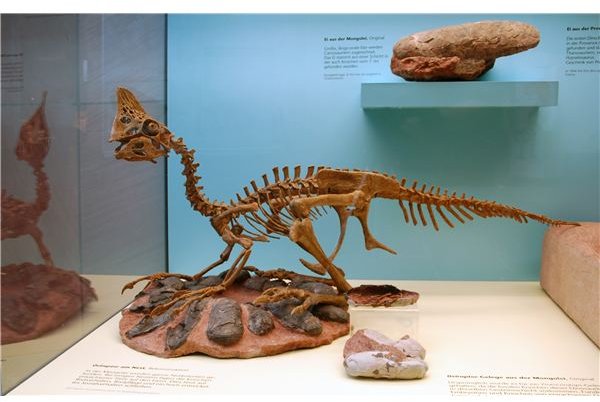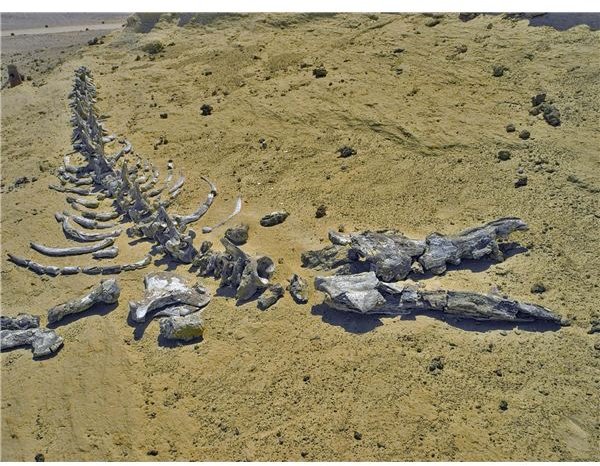Fossils Found in the Desert include Dinosaurs in the Gobi Desert
Desert Fossils include Dinosaurs, Whales, Penguins and Crocodiles
Fossils are found in the desert in many locations around the world. New fossils are discovered by teams of paleontologists who spend long days in the hot sun to excavate their fossil finds. After the fossils have been excavated the paleontologists spend months analyzing them, and putting the finds into an evolutionary context. For instance, whale fossils found in the “Whale Valley”, the Western Desert of Egypt, sheds light on how whales evolved from a land-based animal to an ocean-based animal 37 million years ago.
Whale fossils are just one kind of fossils found in the desert. Here are more of the most famous fossils found in the desert:
- Dinosaur, mammal and lizard fossils in the Gobi Desert in Mongolia (Cretaceous, 146 to 65 million years ago)
- Whale fossils in Wadi al-Hitan (aka Whale Valley) in the Fayoum area, the Western Desert of Egypt (Eocene period, app 37 million years ago)
- Penguin fossils in the Atacama Desert in Peru (Eocene period, 36 to 41 million years ago)
- Dinosaur fossils in the Sahara Desert in Morocco (Middle Cretaceous, 100 million years ago)
- Crocodile fossils in the Sahara Desert in Niger (Middle Cretaceous, 110 million years ago)
- Trilobites in the Mojave Desert, California (Cambrian, 543 to 490 million years ago)
- Mammals, birds and fish in the Mojave Desert, California (Pleistocene,1.8 million years ago to 10,000 years ago)
The Oviraptor - Egg Thief or a Dedicated Mom?
The most famous fossils found in the desert are undoubtedly fossils of the Oviraptor, the “egg seizer”, a small carnivorous dinosaur. The abundance of well preserved mammal and dinosaur fossils in the Gobi Desert in Mongolia was first discovered in the 1920’s by an expedition from the American Museum of Natural History led by Roy Chapman Andrews. More than 1000 mammal skulls and 60 different species of dinosaurs have been excavated in Gobi. Gobi Desert fossils are from Cretaceous, the geological time period from 146 to 65 million years ago

.
It was originally thought that the Oviraptor stole and ate eggs laid by other dinosaurs, because the first find of the Oviraptor was next to what was thought to be eggs from another species, Protoceraptops. However, in 1993 Mark Norell and his team, likewise from the American Museum of Natural History, unearthed a remarkable fossil: an adult Oviraptor sitting on a nest of 22 eggs. The eggs were shown to be from the Oviraptor. The Oviraptor is therefore no longer considered an egg thief, but on the contrary; a dedicated parent protecting and brooding its eggs. The Oviraptor fossil was a very significant find because it is evidence that brooding behavior evolved before the origin of modern birds.
Amazing Fossil Finds are Often a Coincidence

New fossils are found in the desert all the time. Paleontologists go to great lengths to find more fossils in the deserts around the world, and they never know what they will find next. Often they set out to find one kind of fossil and are surprised to find another. Andrews went to the Gobi Desert hoping to find fossils that would shed light on the evolution of humans, but instead he found an abundance of dinosaur and mammal fossils. Paleontologist Paul Sereno and his colleagues went to the Sahara Desert in Niger to search for dinosaur bones, but instead discovered a fossil of a giant crocodile_, Sarcosuchus imperator,_ up to 40 feet long_._ But no matter which fossils are found they are all a piece of the evolutionary puzzle, and sometimes really extraordinary fossils, such as the Oviraptor or the Sarcosuchus are found.
References
Enzel Y., Wells, S.G. & Lancaster N. Paleoenvironments and paleohydrology of the Mojave and southern Great Basin Paleoenvironments and paleohydrology of the Mojave and southern Great Basin, The Geological Society of America 2003: https://books.google.co.za/books?hl=en&lr=&id=leJuxIWDLbMC&oi=fnd&pg=PA43&dq=+Manix+Formation&ots=tsDXxZC1Gj&sig=LhZoL8n71P8pRhudx4Zi3VuxaCc#v=onepage&q=Manix%20Formation&f=false
Gingerich, P. D. "Early evolution of whales: a century of research in Egypt.“In Fleagle J. G. & Gilbert C.C. (eds.), Elwyn Simons: A Search for Origins, Springer, New York, 2007, pp. 107-124.: https://www-personal.umich.edu/~gingeric/PDFfiles/PDG471_WhalesinEgypt.pdf
Moskvitch K. “Ancient Giant Penguin Unearthed in Peru”, BBC News, Science and Environment, 30 Sep 2010: https://www.bbc.co.uk/news/science-environment-11420635
Norell M. A., Clark J.M., Chlappe L.M. & Dashzeveg D. "A Nesing Dinosaur”, Nature Vol 378 21/28 December 1995: https://www.bi.ku.dk/dna/course/papers/I2.norell.pdf
Osborn H. F. _"_Three New Theropoda, Protoceratops Zone, Central Mongolia", American Museum Novitates, Nov 7. 1924: https://home.comcast.net/~theropod-archives/pdf/Osborn_1924_AMN_144_1.pdf
Parsell D.L., ““SuperCroc” Fossil Found in Sahara”, National Geographic, Oct 25 2001: https://news.nationalgeographic.com/news/2001/10/1025_supercroc.html
University of California, Museum of Paleontology: https://www.ucmp.berkeley.edu/cambrian/marblemts.html
Wilford, J. N. “For Fossil Hunters, Gobi Is No Desert”, New York Times, 13. Sept. 2005: https://www.nytimes.com/2005/09/13/science/13gobi.html?_r=2
Photo Credit
Whale fossil in Wadi al-Hitan: https://commons.wikimedia.org/wiki/File:Dorudon_skeleton.jpg
Oviraptor: https://commons.wikimedia.org/wiki/File:Oviraptor_Senckenberg.jpg, photographer Eva Kröcher licensed under the GNU Free Documentation License (GFDL)
Sarcosuchus skull_:_ https://commons.wikimedia.org/wiki/File:Sarcosuchus_skull.JPG?uselang=en-gb, User Barracuda1983
This post is part of the series: All About Fossils
This article series focuses on fossils. It includes a guide to the major groups of fossils, explores which fossils are found in the deserts around the world, describes how deep sea fossils are used to shed light on evolutionary events, explains the fossil record, and describes how fossils are formed
